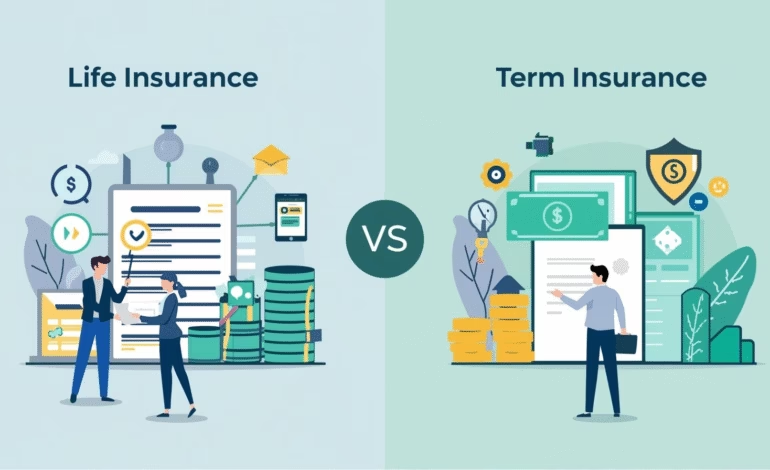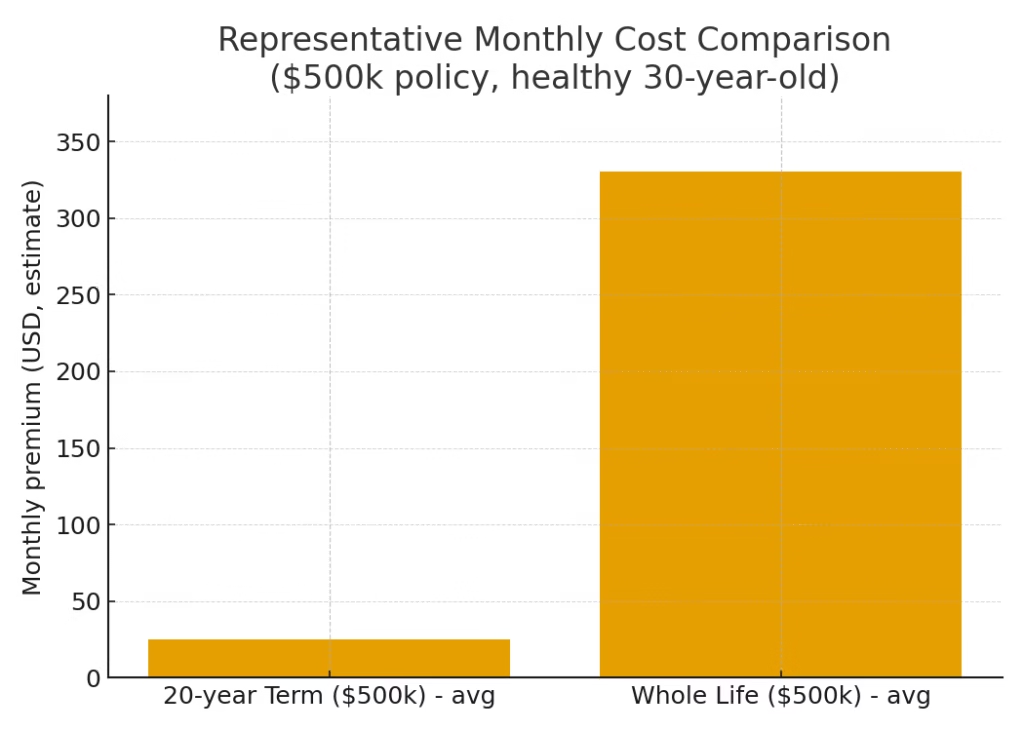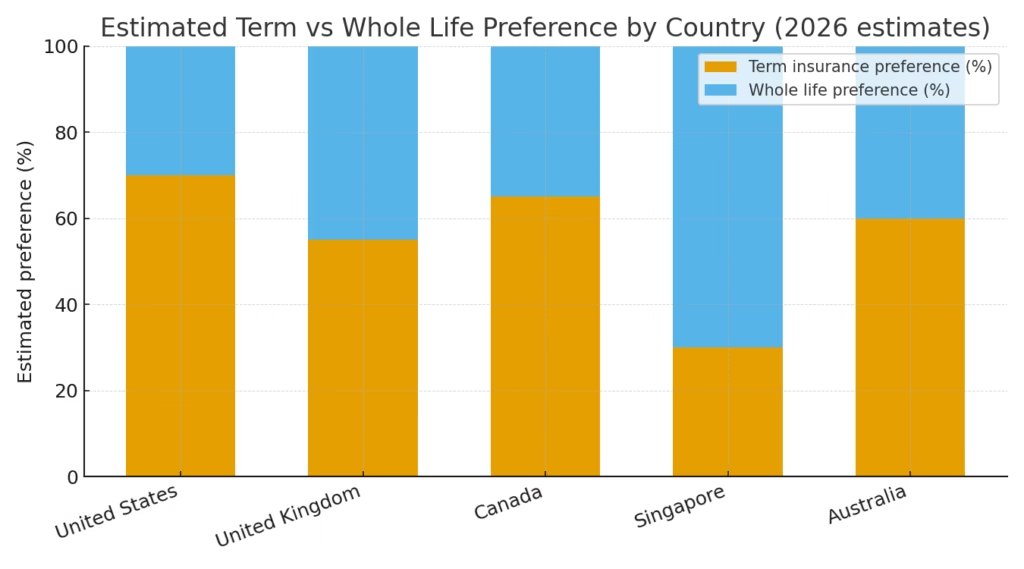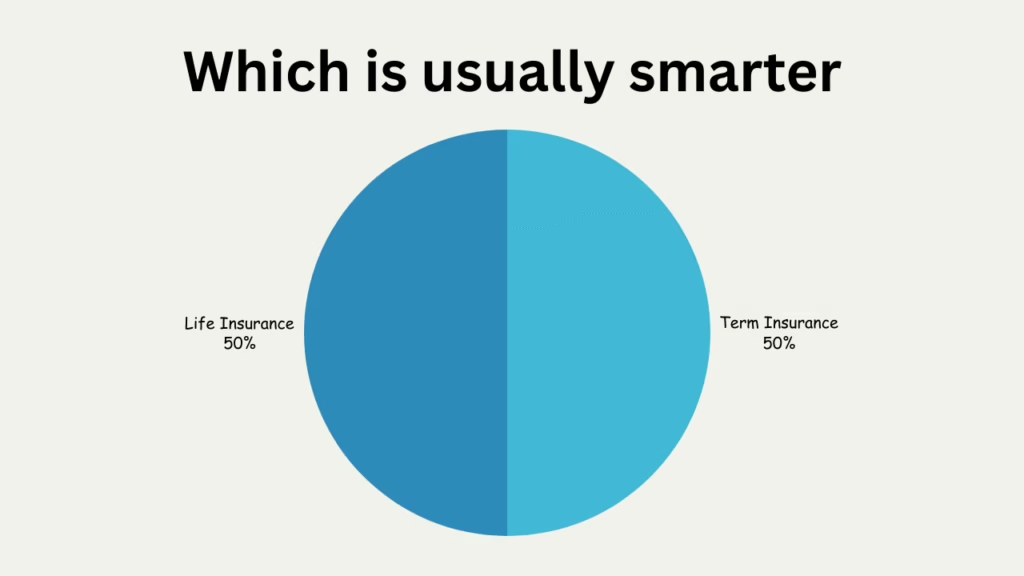
The Big Question for 2026
When it comes to protecting your loved ones financially, insurance is not optional. It is essential. But the big question many people in the US, UK, Canada, Singapore, and Australia are asking in 2026 is simple: Life Insurance vs Term Insurance: Which Is Smarter in 2026?
Both have unique benefits. Life insurance provides lifelong coverage with added cash value, while term insurance gives you affordable protection for a set number of years. Choosing between them is not always straightforward. It depends on your age, financial goals, and long-term plans.
Quick Quiz for You:
If you had the choice between lower premiums today or guaranteed lifelong coverage, which would you choose?
(My Reply: “I would choose lower premiums now!” Because That is why many young professionals lean toward term insurance, but it is not always the best choice long term.)
What Is Life Insurance?
Life insurance, sometimes called whole life or permanent insurance, provides coverage for your entire life as long as premiums are paid. Unlike term insurance, it also builds a cash value that can be borrowed against or even used as an investment.
Key Features of Life Insurance:
- Lifetime coverage.
- Cash value grows over time.
- Premiums are usually higher.
- Can be used as part of retirement planning.
For Example:
Imagine a 40-year-old professional in New York. He buys a whole life insurance policy and keeps paying premiums. By the time he retires at 65, his policy has built up significant cash value that he can borrow against.
Question: “Can I use life insurance cash value for education expenses?”
Answer: Yes, many policyholders use their cash value to fund education, retirement, or even emergencies.
What Is Term Insurance?
Term insurance is simpler. It provides coverage for a fixed period, usually 10, 20, or 30 years. If the policyholder passes away during the term, the beneficiaries receive a payout. If the term ends and no claim is made, the coverage expires without value.
Key Features of Term Insurance:
- Affordable premiums.
- Coverage for a specific period.
- No cash value or investment element.
- Easy to understand and buy.
For Example:
A young couple in Toronto, both in their 30s, take out a 20-year term insurance policy to cover their mortgage. If something happens to either of them during this period, the insurance ensures the family does not lose the home.
Quick Question for You:
Would you prefer a lower premium with no savings element or a higher premium with investment growth?
(My reply: Lower premium, That is the main reason why term insurance is often popular with younger buyers.)
Life Insurance vs Term Insurance: Core Differences
Now that we understand the basics, let us compare the two head-to-head.
| Feature | Life Insurance | Term Insurance |
|---|---|---|
| Duration | Lifetime | Fixed term (10–30 years) |
| Premiums | Higher | Lower |
| Cash Value | Yes | No |
| Investment Component | Yes | No |
| Best For | Long-term wealth planning | Short-term affordable protection |
Quiz for you:
Looking at the table, which type would you recommend for a 25-year-old starting a family?
My Answer: “Term insurance, because it is affordable!”. Great choice for beginners, but later in life, switching to life insurance may make sense.

Real-Life Example: US vs Singapore
Let us compare two real-world scenarios.
- US Example: A 35-year-old parent in Texas chooses term insurance for 20 years to cover mortgage and children’s education. Premiums are low, making it affordable during high-expense years.
- Singapore Example: A 50-year-old business owner chooses whole life insurance. Premiums are higher, but it doubles as a financial planning tool with cash value benefits that support retirement.
Question: “Why is life insurance more popular in Asia than in the US?”
Answer: In Asia, people often prefer life insurance because of the cash value component, which acts as savings. In the US, affordability often makes term insurance more attractive.
Cost Analysis in 2026
When people compare life insurance and term insurance, cost is often the biggest deciding factor. Term insurance is generally much cheaper, while life insurance is more expensive but offers additional benefits.
For example:
- A 30-year-old non-smoker in the US might pay around 20 to 30 dollars per month for a 20-year term policy with 500,000 dollars coverage.
- The same person might pay 200 to 300 dollars per month for a whole life insurance policy with the same coverage.
This price difference is why many younger families start with term insurance.
Question for you: If you had to pay 200 dollars a month for life insurance versus 30 dollars a month for term insurance, which would you pick in 2026?
Best Term Life Insurance Policy Companies.
Pros and Cons of Life Insurance
Pros
- Lifetime coverage ensures peace of mind.
- Builds cash value that can be borrowed or used for retirement.
- Can act as part of estate planning.
Cons
- Higher premiums compared to term insurance.
- More complex to understand.
- Returns on cash value are usually lower than other investments.
For Example:
A business owner in London used life insurance as a tool for estate planning. When he passed away, the policy payout helped his children settle inheritance taxes without selling family assets.
Pros and Cons of Term Insurance
Pros
- Very affordable, especially for young buyers.
- Straightforward and easy to understand.
- Provides high coverage for a low price.
Cons
- No cash value, coverage ends when the term ends.
- If you outlive the policy, premiums paid do not return.
- Renewing later in life becomes more expensive.
For Example:
A family in Sydney purchased a 20-year term plan. It covered their mortgage during the crucial years, but once the policy ended and they had not made a claim, they had no benefits left.
Question for you: Would you feel disappointed if you paid for term insurance for 20 years and never claimed it?
(My reply would be: “Yes, it feels wasted.” Many people feel the same, which is why some prefer life insurance for lifelong security.)
Regional Insights: How Different Countries View Insurance in 2026
United States: Term insurance dominates because affordability matters most for families balancing mortgages and education expenses.
United Kingdom: Both life and term insurance are popular, but whole life policies often appeal to older individuals for estate planning.
Canada: Term insurance is very common, but life insurance is slowly gaining attention among high-income groups who want investment features.
Singapore: Life insurance is widely preferred due to the cultural emphasis on savings and wealth planning.
Australia: Term insurance remains strong for families, but there is a growing interest in hybrid products that combine term with investment benefits.
Question for You: If you live in one of these countries, which type of insurance do you personally see your friends or family buying more often?

Which Is Smarter in 2026 Based on Age?
Your age plays a major role in deciding between life insurance and term insurance.
- In Your 20s and 30s: Term insurance is usually smarter. It is affordable, and it covers big financial risks like student loans, mortgages, or starting a family.
- In Your 40s and 50s: Many start shifting toward life insurance for long-term planning. By this age, building cash value becomes appealing.
- In Your 60s and Beyond: Whole life insurance is often chosen to support estate planning, retirement, and wealth transfer.
For Example:
A 28-year-old professional in Toronto might only need term insurance to cover debts and early family expenses. On the other hand, a 55-year-old in Singapore might prefer whole life insurance to ensure guaranteed benefits for retirement and heirs.

Case Study: Family Scenarios in 2026
Scenario 1: The Young Family
John and Emma, both 30, live in the UK with two small children. They buy term insurance for 20 years, covering their mortgage and childcare needs. It costs them less than a weekly dinner out.
Scenario 2: The Mid-Career Professional
Sophia, 45, in New York, has paid off most of her mortgage. She invests in life insurance, knowing it will provide lifelong protection and cash value for retirement.
Scenario 3: The Retired Couple
Raj and Anita, 65, in Singapore, choose life insurance to leave a legacy for their children. The cash value also supplements their retirement savings.
Question for you: Which of these three scenarios feels most similar to your life right now?
Frequently Asked Questions
Over the years, I have seen readers and clients ask the same questions when deciding between life insurance and term insurance. Let us go through them clearly.
Is life insurance always better than term insurance?
Not necessarily. Life insurance provides lifetime coverage and builds cash value, but it is more expensive. Term insurance is smarter for people who want affordable protection for specific financial responsibilities, like a mortgage or children’s education.
Can I convert term insurance to life insurance?
Yes, many insurers allow conversion from term to life policies. For example, in the US and Canada, some 20-year term plans include a conversion option without requiring a new medical exam.
What happens if my term insurance ends and I am still alive?
The coverage simply ends. There is no payout. This is why some people feel more comfortable with life insurance, which guarantees lifelong benefits.
Which option is better for retirement planning?
Life insurance is better suited for retirement planning because of its cash value growth. Term insurance, while affordable, does not provide this feature.
Is life insurance tax-free?
In most Tier 1 countries, including the US, UK, Canada, Singapore, and Australia, the death benefit from life insurance is usually tax-free for beneficiaries. However, always check local regulations.
Question for You: Which one of these questions did you want answered the most?
Future Trends in 2026 and Beyond
Insurance is not just about today, it is also about tomorrow. Here are the trends shaping the future of life and term insurance.
1. Digital-First Insurance Platforms
More people now buy policies online without ever meeting an agent. Comparison sites and digital apps are streamlining the process.
2. Hybrid Products
Insurers are launching hybrid plans that combine the affordability of term insurance with the investment features of life insurance. This is already popular in Australia and Singapore.
3. AI and Personalization
Artificial intelligence tools are helping insurers create personalized quotes. By 2030, we may see policies tailored to your lifestyle habits, fitness data, or even travel patterns.
4. Sustainability Focus
Consumers in the UK and Canada are asking insurers to invest responsibly. Policies may soon come with options that link to sustainable investments.
For Example:
Imagine an app on your phone that tracks your health habits. If you walk 10,000 steps daily, your insurance premiums decrease automatically. This is not science fiction. Some insurers in Singapore and the US are already testing it.
Which Is Smarter in 2026: Life or Term Insurance?
The answer depends on your personal situation.
- If you are young, have a tight budget, and need protection mainly for a mortgage or childcare, term insurance is usually the smarter choice.
- If you are older, want lifelong protection, and like the idea of building cash value, life insurance may be smarter.
- For many people, the best strategy is to start with term insurance and later switch or convert to life insurance when their financial situation improves.
Question for you: If you had to choose today in 2026, would you go with life insurance or term insurance?
Practical Tips Before You Decide
- Compare Multiple Quotes: Use online comparison websites to see real prices.
- Check Conversion Options: If you buy term insurance, make sure it can convert to life later.
- Think About Long-Term Goals: Are you protecting short-term debt or planning generational wealth?
- Consult a Financial Advisor: Especially for estate planning or tax questions.
- Revisit Your Policy Every Few Years: Your needs will change as life progresses.
Case Study: Blended Approach
Some families choose both life and term insurance together. For example, a couple in Vancouver bought a small life insurance policy for lifelong protection and a large term insurance policy to cover their mortgage for 25 years. This balanced approach gave them peace of mind and kept costs manageable.
Question: “Can I really have both life and term insurance?”
Answer: Yes, many insurers allow you to combine policies. This way, you get affordable coverage now and guaranteed benefits later.
Final Thoughts
Choosing between life insurance and term insurance in 2026 is not a one-size-fits-all decision. Both options have clear advantages. Term insurance wins for affordability and simplicity, while life insurance shines for long-term security and financial planning.
The smarter choice is the one that aligns with your financial goals, family needs, and future vision. Start by asking yourself: Do I need short-term protection or lifelong security?
If you are unsure, consider speaking with a trusted advisor and using insurance comparison websites that give you side-by-side options.
Question for you: Have you made your decision yet for 2026? Which do you believe is smarter, life insurance or term insurance? Share your answer in the comments, your story might help another reader make the right choice.



